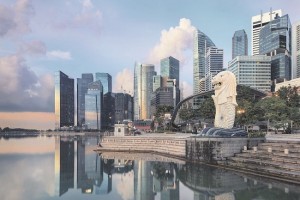Q2 office rents accelerate, Frasers Tower nearly 80% occupied
 Grade A office space in Singapore’s core central business district (CBD) recorded a quarterly rental gain of 4.1 percent in Q2 2018 – the fastest pace of growth since Q1 2014, according to real estate consultancy CBRE.At the same time, overall office vacancy across the city-state remained unchanged at 5.9 percent on a quarterly basis. This is despite 700,000 sq ft of office stock entering the market thanks to the completion of the 38-storey Frasers Tower, where nearly 80 percent of the space has been taken up by tenants such as Microsoft, Total, ABN and Sumitomo Corp.“The fairly tight vacancy environment in the Grade A office market has encouraged office landlords to continue to press for higher rents as they seek to gain benefit from the market upswing,” said Moray Armstrong, managing director for advisory & transaction services at CBRE Singapore.The flexible office space segment continues to be particularly active, with existing market players announcing several new locations. For instance, IWG’s lifestyle co-working brand Spaces has agreed to occupy over 35,000 sq ft of space at TripleOne Somerset, while JustCo has committed to lease 17,000 sq ft at MacDonald House.Homegrown insurance companies also expanded, with Great Eastern and NTUC Income Insurance Co-operative taking up space at the upcoming Paya Lebar Quarter project, which has seen robust rental demand in the first half of 2018.“In spite of improving office sentiment, leasing enquiry levels and expansion requirements have not been quite as positive over the past couple of quarters as tenants grapple with a rising rental market environment. Key demand drivers have thus far been concentrated in flexible space operators and technology firms and to a lesser degree insurance companies,” Armstrong noted.While the medium term outlook for Singapore’s office rental market is positive due to a tapering supply pipeline, market players still need to be cautious.“Potential risks remain, particularly on the demand side, in light of recent escalations in trade disputes and the possible dampening effects on global economic growth. Both providers and end users of space will need careful navigation through the next six to 12 months as the actual strength of the market advancement is tested,” Armstrong added.Source: CommercialGuru, 3 July 2018
Grade A office space in Singapore’s core central business district (CBD) recorded a quarterly rental gain of 4.1 percent in Q2 2018 – the fastest pace of growth since Q1 2014, according to real estate consultancy CBRE.At the same time, overall office vacancy across the city-state remained unchanged at 5.9 percent on a quarterly basis. This is despite 700,000 sq ft of office stock entering the market thanks to the completion of the 38-storey Frasers Tower, where nearly 80 percent of the space has been taken up by tenants such as Microsoft, Total, ABN and Sumitomo Corp.“The fairly tight vacancy environment in the Grade A office market has encouraged office landlords to continue to press for higher rents as they seek to gain benefit from the market upswing,” said Moray Armstrong, managing director for advisory & transaction services at CBRE Singapore.The flexible office space segment continues to be particularly active, with existing market players announcing several new locations. For instance, IWG’s lifestyle co-working brand Spaces has agreed to occupy over 35,000 sq ft of space at TripleOne Somerset, while JustCo has committed to lease 17,000 sq ft at MacDonald House.Homegrown insurance companies also expanded, with Great Eastern and NTUC Income Insurance Co-operative taking up space at the upcoming Paya Lebar Quarter project, which has seen robust rental demand in the first half of 2018.“In spite of improving office sentiment, leasing enquiry levels and expansion requirements have not been quite as positive over the past couple of quarters as tenants grapple with a rising rental market environment. Key demand drivers have thus far been concentrated in flexible space operators and technology firms and to a lesser degree insurance companies,” Armstrong noted.While the medium term outlook for Singapore’s office rental market is positive due to a tapering supply pipeline, market players still need to be cautious.“Potential risks remain, particularly on the demand side, in light of recent escalations in trade disputes and the possible dampening effects on global economic growth. Both providers and end users of space will need careful navigation through the next six to 12 months as the actual strength of the market advancement is tested,” Armstrong added.Source: CommercialGuru, 3 July 2018